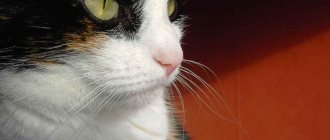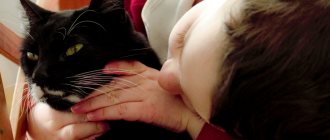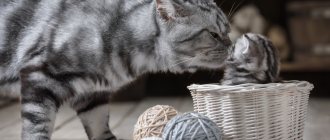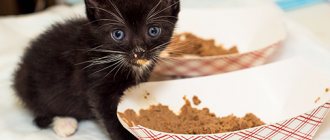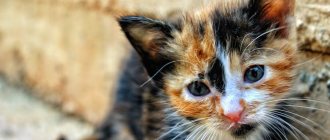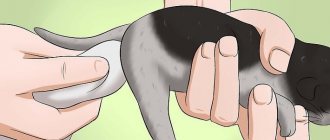In the process of litter box training, playful kittens often not only perceive the litter as a toy, scattering it around the tray, or even taking it throughout the apartment. Sometimes kittens get so carried away that they start swallowing unappetizing pieces. The kitten has a litter, what should the owner do in such a situation?
How dangerous is litter for a kitten if he swallows a piece? How to wean kittens from playing with litter and eating it? Or maybe it’s better to avoid the filler altogether? Let's figure it out.
Why does a kitten eat litter?
It would seem that the filler, be it clay, wood or silica gel, can hardly attract with its taste... However, as they say, there is no arguing about tastes. Some fragrances with which the litter is flavored may seem so attractive to the kitten that he will risk trying the inedible substance “on the tooth.” And you know, he might like it, after all, some people also like very strange things... moonshine, for example.
But more often than not, it happens differently. When playing, kittens, like children, put everything in their mouths. But if the string or candy wrapper can be freely released from the mouth, then the filler, especially clumping one. Sticks tightly to the tongue or palate. And the poor baby has no choice but to try to swallow the interfering lump.
The need to contact a veterinarian
Even if there are no signs of health problems and your pet looks great, you should seek help from a veterinarian. A qualified specialist is able to determine the substances that a pet is deficient in. By prescribing the medications necessary for use, the veterinarian will be able to calm the cat’s desire to eat fillers.
If you urgently contact a specialized animal clinic, you must take a box of litter with you. It is needed so that the veterinarian can clarify the drug that will be dealt with and more quickly navigate the content of emergency care for the pet.
If a cat is lethargic, weakly active, or sleepy, then it is necessary to ensure its delivery to the clinic as soon as possible, since there is a possibility that the mixture will be retained in the animal’s body and subsequent blockage of the digestive system. The main signs of emerging health difficulties may include:
- excessive aggressiveness;
- lethargy;
- excessive fearfulness;
- refusal to eat food;
- heart rate is too high;
- increased salivation.
As soon as it is noted that the animal is not indifferent to the litter from the tray, all measures must be taken to resolve the problem. Such behavior of an animal can lead to the most serious consequences, so it is extremely important to eliminate this habit as soon as possible.
Is it dangerous if a kitten eats litter box?
A few swallowed pieces of the filler will not cause any harm to the baby. Undigested remains will safely leave his stomach naturally. The fillers do not contain any poisons.
It is dangerous if the kitten gets a taste of the clumping litter. Once wet in the mouth or stomach, its particles form a dense lump, just like in the tray. And if this lump turns out to be large, it can clog the esophagus and intestines. An urgent operation will be required to save the little sufferer.
Silica gel filler can also be dangerous for a kitten. Its particles have a unique ability to absorb moisture. And a few of these grains, once in the stomach, can cause a lot of unpleasant moments for the baby. In addition, silica gel, when wet, becomes sticky, so grains can stick to the larynx and esophagus, which is not only unpleasant, but also life-threatening.
What are the dangers of eating pellets?
Most manufacturers do not add any toxic substances to their raw materials. However, eating pellets from a litter tray is not the healthiest activity for a pet of any age. Particles of the mixture stick to the roof of the mouth and the cat's tongue, forming viscous lumps that are very difficult to spit out. This can lead to constipation or suffocation.
Silica gel granules can cause particular harm to health. They have good absorbent properties, and they swell greatly once they are in the animal's stomach. Their presence causes discomfort and can further lead to serious problems in the gastrointestinal tract. The most dangerous consequences are intestinal obstruction or severe poisoning.
What litter is best for kittens?
Fillers made from wood waste are considered the safest and most environmentally friendly. That's what they're called - woody ones. Their granules are quite large and difficult for a kitten to swallow. In addition, wood pellets, when wet, literally crawl apart, turning into fine dust. So, even if swallowed, they will not cause the slightest harm. Another advantage of wood filler is that used wood filler can be flushed down the toilet (at least that’s what the manufacturers say).
There is also a more exotic option - corn filler. It is similar to wood, but is made from corn waste. Absorbs moisture perfectly and retains odors, absolutely harmless, even if the kitten eats it. The disadvantages are the fairly high cost and high consumption. After all, it will have to be changed completely (unlike clumping).
Special fillers labeled “for kittens” are also absolutely safe.
Causes
In order to wean a cat from this habit, you need to clearly understand the reason for its manifestation. Modern veterinarians identify the following main reasons for this behavior in cats.
Physiological – reasons related to the natural needs of pets:
- animals lack minerals and vitamins that enter their bodies with food. Cats, like all other animal species, need various minerals and vitamins for normal functioning. If a person can neglect such needs, then the cat will try to make up for the lack of useful substances from its environment.
- cats are predators by nature. That is why they sharpen their nails and teeth. To minimize their labor costs, they choose to sharpen their teeth what is closest to them. Filler is often chosen as an object for sharpening teeth. Thus, the balls in the silica gel mixture are quite hard and when exposed to them, the teeth are sharpened.
If there is a lack of calcium in a cat’s body , which plays an important role in strengthening and active growth of bones, the pet will try to replenish this substance through the consumption of calcium-containing components, which include litter.
Something with the psyche. Often the reasons for such cat behavior are hidden in the field of animal psychology. Animal psychologists, when explaining the reasons for using filler due to stress and disorders, use such a concept as “food perversion.”
In addition, you must remember that visiting your cat litter box is a way to calm down and feel protected.
How to stop a kitten from eating litter box?
A kitten can chew an inedible object only in one case - it is bored and is looking for something to have fun with. Even if out of curiosity he takes a couple of lumps into his mouth, he will quickly realize that it is not at all tasty.
What should you do if you see your kitten playing with the litter and tasting it? You should not scold your baby, because he is unlikely to understand the reason for your dissatisfaction, and may even begin to be afraid of the tray.
It is better to praise the child and distract him with an interesting game. Have a few balls in reserve (rubber balls from vending machines for 10 rubles apiece are great), shoelaces, hair ties, pieces of crumpled candy foil, and crispy cellophane candy wrappers. Many kittens can play for hours with such a wrapper tied with a regular laundry elastic band. The other end of the elastic band is tied to the door handle. Length – to the floor or slightly shorter. Fun guaranteed for days to come!
Reasons why a cat may eat litter
The main reasons why a cat eats litter are divided into two large groups - physiological and psychological. To identify the true provoking factor, you need to familiarize yourself with each in more detail.
Many kittens try to eat litter
Physiological reasons
Physiological characteristics are determined by the lifestyle and character of the pet. For optimal functioning of all organs and systems, the body must receive the entire complex of vitamins, minerals, macro- and microelements. Calcium is important for the development of bone tissue, which is found in high concentrations in toilet fillers.
Note! If a cat’s body needs a certain substance, it will look for it in surrounding objects. And it doesn’t matter whether the item is edible or not.
This means that in order to solve problems, it is recommended to enrich your beloved pet’s diet with vitamin and mineral supplements, which contain a high concentration of calcium. If the pet still does not stop eating the litter, it urgently needs to be replaced with another, otherwise the consequences can be disastrous.
The most dangerous cat litter is silica gel, which is characterized by pronounced moisture-absorbing properties. It can simply stick to the mucous membranes of the digestive system, which leads to serious disorders and even death.
Sharpening teeth
By their nature, all cats are predators, and they need to sharpen not only their claws, but also their teeth. It is quite possible that there are no suitable items in the house to do this with the exception of filler, which in its structure and size is ideal for this.
Calcite pieces for cats to sharpen their teeth
To wean your pet from doing this, it is enough to let the animal chew on a small bone at a certain time interval.
For your information! You can purchase a piece of calcite at any pet store, which is ideal for these purposes. It is impossible to chew it, but the teeth will be sharpened.
Psychological reasons
It has been scientifically proven that cats are more susceptible to stress than humans. Against this background, they often develop food perversion. A cat's litter box is an important and integral part of their life, so by absorbing the litter, they feel more confident and calm.
When you see that a kitten is eating litter, you should not scold it; it is better to calmly take it in your arms, stroke it, and show your care and affection as much as possible. Until the psycho-emotional health of the animal is normalized, you cannot scold it.
Note! You can diversify your cat's life with different games.
What to do if the kitten stubbornly tries to eat the litter?
There are few options here. The first - radical - abandon the filler completely. A tray with a grid is perfect for such purposes. On the plus side, you no longer have to spend money on buying filler. And the kitten will lose the habit of putting inedible things into its mouth. In addition, cleaning will be easier - there is a lot of dust from the filler, and the kitten will drag its particles throughout the apartment on its paws. And one more thing - you will always know exactly how often the kitten goes to the toilet and control the color, consistency, and smell. The filler quickly teaches owners not to pay attention to such trifles.
There are also disadvantages - you will have to wash the tray much more often. Sometimes - after each use. And the smell - now the aroma will spread throughout the house.
You can avoid the latter if you use filler, just pour it under the grate of the tray. This way, odors will spread much less, and the litter box will have to be cleaned only after pooping, usually 1-2 times a day for kittens. And filler consumption is reduced significantly. And the paws are clean.
What to do if your cat has eaten pellets?
After such an incident, the animal must be shown to a veterinarian for assistance.
If your cat has eaten silica gel filler, bentonite, or parts of minerals, you need to rinse the mouth and then quickly take your pet to the veterinarian. The younger the animal, the higher the risk of death. Death in a kitten that has eaten silica gel can occur within 48 hours. Be sure to take a sample of the granules and packaging with you.
If it is not possible to immediately show your pet to a doctor, then you should try to induce vomiting, for example, by injecting salted water into the kitten’s mouth. To prevent the baby from choking, the liquid must be administered using a syringe with the needle removed. Until your pet’s health returns to normal, you need to exclude dry food from the baby’s diet and add more fiber, which is found in vegetables. Bran will help improve intestinal motility.
Physiological reasons
Correctly answering the question of why kittens sometimes eat litter is not easy. Some people lack nutrients, others like the taste. The owner should watch the kitten for some time to determine the reason for eating the litter.
Lack of vitamins and minerals
A kitten's growing body requires the necessary supplements to strengthen its teeth and claws. If a pet feels a lack of phosphorus or calcium, then it begins to look for sources of minerals. A litter of clay, sawdust, and other natural ingredients in a tray can provide such a source. Wood litter is also often eaten by fiber deficient kittens.
To avoid such situations, the owner should add meat and dairy products to the kitten's diet or use dry food that contains vitamins and minerals in the proper quantities.
A kitten may eat litter due to a lack of vitamins and minerals
Sharpening teeth
One of the physiological reasons why a kitten eats litter is the need for regular teeth grinding. Kittens are predators by nature and grinding of fangs is “in their blood.” Thus, the solid filler instantly attracts their attention. The kitten is trying to sharpen its teeth on the filler granules. In this case, the owner needs to purchase special devices or offer the kitten a hard treat.
Another reason for a kitten to eat litter is teeth renewal. At about 4-6 months, baby teeth begin to be replaced by molars and kittens begin to gnaw on various hard objects.
Give your kitten a special dental treat
Mental disorders
Pica is a disorder similar in severity to anorexia and bulimia. Expressed in the desire to eat inedible objects. Appears as a result of mental disorder, nervous shock and can lead to death.
Research by scientists on animal behavior has revealed that pets, just like people, are susceptible to depression and fear. Pica in science is divided into two types:
- A common disorder is eating paper, stones, and earth.
- Coprophagia is the eating of feces.
Cats are susceptible to both forms of the disease. In order to determine why a cat eats soil from a psychological point of view, it is necessary to analyze all the facts from the pet’s life.
The problem could begin in childhood, especially for animals picked up from the street at an early age. Starvation leads to death after 3-4 days. Even if the kitten was rescued during this period and provided with the required care, the consequences of the injury may appear several years later. The animal will more often suffer from gluttony throughout its life, and this often leads to the second type of eating disorder - coprophagia.
It is more difficult for a domestic cat to experience hunger, which, due to circumstances, finds itself on the street and is forced to remain without food. Having found a secluded refuge, the pet hides and the feeling of fear blocks the need for food. The pet is paralyzed by fear and prevents it from moving. If the owners manage to find the animal and save it, then recent impressions haunt the shocked person for a long time. Here is another psychological reason why a cat eats soil from indoor pots.
Non-pathological causes
You can often find a growing kitten eating sand. This phenomenon can be considered normal if the situation does not repeat itself too often. This behavior is understandable from the point of view of felinologists and veterinarians:
- New and unknown . The kitten is actively exploring the world around it. He is interested in new objects with different consistencies, and sand is one of them.
- Exciting aroma . If a cat eats sand on the street, perhaps food fell on it some time ago, and accordingly, it smells “delicious”, attracting the pet.
- Cleaning and sharpening teeth. This is another reason why cats periodically eat sand.
If the situation with the use of sand is repeated frequently, this is highly likely to indicate a number of diseases and pathological conditions: both physiological and psychological.
How to wean your pet from a harmful activity?
In principle, there is nothing wrong with cleansing the body with soil from indoor pots for a cat. It is important that there are no harmful elements in the soil. And since urban soil contains toxins, gasoline impurities and other chemical compounds, the soil on the street and in the garden is not safe for cats. Finding environmentally friendly soil in modern life is extremely difficult.
Instead of being beneficial, the consequences of consuming such soil can be very disastrous. Therefore, special pastes that dissolve wool or green grass will replace the earthen sorbent.
Proper cat care, good nutrition, games, walks and regular preventive examinations by a veterinarian will help keep your pet healthy.
Diseases and pathologies associated with sand consumption
Most often, a “craving for eating sand” indicates the presence of corresponding diseases that occur in the cat’s body with varying degrees of severity:
- Problems with teeth, presence of tartar. If their teeth hurt, cats try to relieve the discomfort by eating sand. The pet must be carefully examined in the oral cavity and, if there are damaged teeth, immediately taken to the veterinarian. Dental problems can negatively affect the health and functioning of the digestive system.
- Iron deficiency anemia – this disease affects not only humans, but also often cats. The animal believes that sand will help replenish the lack of iron in the body. A sign of anemia that the owner can notice is that the cat is constantly looking for a source of heat, since iron deficiency anemia lowers body temperature.
- Worms. If there are parasites in the intestines, the murka experiences extremely unpleasant and painful sensations. With helminthic infestations, the cat’s body experiences a lack of vitamins and minerals. By eating sand, the cat tries to remove parasites. This works in a certain way: sand clogs the intestines, forming a plug in it that displaces parasites. But this only works on wild cats. A pet trying to get rid of worms in this way will cause harm to itself, even to the point of intestinal blockage.
- Intestinal disorders, often accompanied by diarrhea. The cat experiences severe itching in the anal area caused by irritation. By eating sand, the mustachioed tabby tries to get rid of severe discomfort.
- Dysbacteriosis. The cat eats sand in an attempt to normalize the intestinal microflora.
- If a cat has been noticed regularly eating sand, it is necessary to sniff its oral cavity. If the saliva “exudes” the smell of ammonia, you should urgently contact your veterinarian, as this is a sure sign that the cat has acute kidney failure.
- Vitamin deficiency - a lack of vitamins “pushes” the cat to search for additional sources. One of them is sand.
Associated symptoms. The disorders and health problems listed above do not only manifest themselves in the fact that the cat eats sand. The animal refuses to eat, does not show physical activity, and does not make contact with humans. Any changes in your pet's behavior in combination with eating sand are an indication to contact a veterinarian.
